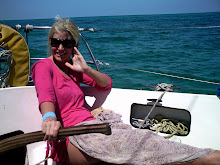
When Pete and I got a new dinghy in Ft. Lauderdale we also picked up a little outboard motor to mount on it. Like our boat this outboard is of British make and, like our boat, is considerably older than both Pete and I. Its a 1976 British Seagull that we got for $75 and got running for about another $100 in parts and a lot of help from our friend John.
We're told its pretty much the simplest outboard ever made. It starts with a pull cord that has to be wound around the top. The cord that came with the motor was somehow left on the dock in Florida and the replacement we made also mysteriously disappeared. Out of the proper diameter rope, the pull cord we now have is just a little too thick for its groove. If its not pulled hard enough, the end sticks in the spinning motor, whipping it around several times a second like a big weed whacker and preventing anyone from getting close enough to shut it down.

Once turned on, the motor is moving forward. There's no clutch and so no reverse or neutral. It starts in gear and stays in gear until being shut off. This means the motor has to be clear of anything that might damage it or the dinghy before it can be started. The easiest way to do this to is for Pete and I to cast off from Strolla and drift free. The ever present wind then immediately begins pushing us towards whatever sharp rocks are closest while we frantically pull on the cord to start the motor. As catastrophe looms, the motor finally catches, coughs to life, and off we zoom. Only near misses so far.
With the motor running smoothly, the next excitement comes when its time to turn it off. The Seagull can only stopped by shutting off the fuel at the tank or covering the air intake. Shutting off the tank takes several minutes because the motor still has to burn through all the fuel in the carburator. Blocking the air intake with your palm is faster but requires keeping your hand firmly in place on the running motor lest it burst suddenly back to life.

Properly timing the shut-off has quickly become an art. Wind speed and direction as well as load characteristics of the dinghy all affect timing. Shut the motor down too late and you slam into the dock, too early and you drift to a stop ten feet out and have to try and start it again.
When it starts we love it. When it doesn't, we hate it. But, down here in the islands, where anchorages are considerably farther from shore, we sure need it.



Marine Outboard Motor in USA for Sale - find the list of top marine outboard motor to buy in USA at low cost. Outboard motor is a portable engine attached to the rear of a boat, combining the engine, propeller, and steering control. Visit: Used Marine Outboard Motor in USA for Sale
ReplyDeleteHonda Marine Outboard Motor in USA for Sale
Yamaha Marine Outboard Motor in USA for Sale
Mercury Marine Outboard Motor in USA for Sale